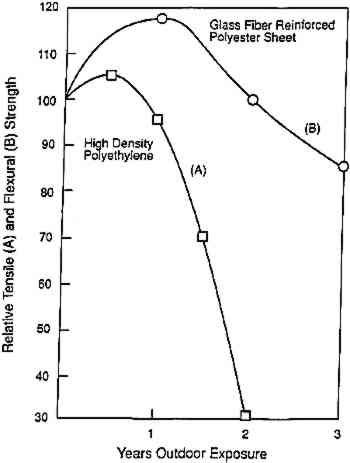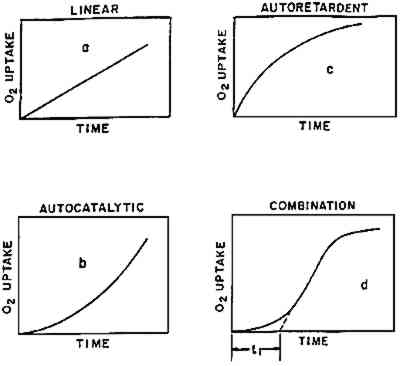ASPECTS OF CHEMICAL RESEARCH IN CONSERVATION: THE DETERIORATION PROCESSROBERT L. FELLER
3 A GAP IN PRESENT KNOWLEDGE? PATTERNS OF DETERIORATIONConservators are fundamentally concerned with retarding the inevitable deterioration of materials. Yet, in this year of 1994, just what is it that we are able to say in answer to the basic question: How do the physical properties of specific organic substances, or systems of such materials, decline with age? If there is not a serious gap, certainly our knowledge of the subject remains limited. There is a general sense that deterioration is rarely a linear process, i.e., that the readily observed changes in properties seldom proceed at a steady rate over time. One may cite many examples, such as those in figure 1, in which plastics and protective coatings initially increase in strength before their properties begin to decline, a decidedly nonlinear pattern of aging (Williams 1993). (This behavior is not universal but is understandable when it occurs. The initial increase in the strength of coatings can come about through cross-linking or the fact that volatile components are lost.) Perhaps
From what is presently known regarding the phenomenon of deterioration, it seems possible to make two statements of general principle: during aging, changes in properties usually (1) are nonlinear over time, and (2) tend to occur in stages. Figure 2, published some years ago (Kelleher 1966; Feller 1977), proposes four basic ways in which the chemical processes of deterioration in organic materials may take place over time. In some cases, perhaps infrequently, the change really does occur in a linear manner (fig. 2a). Far more commonly one observes processes speeding up in time (fig. 2b) or apparently slowing down (fig. 2c). The apparent slowing down of fading or loss of molecular weight is often simply the case of a constant fraction of colorant being lost or chemical bonds being broken in a given unit of time—“first order” decay (Johnston-Feller 1986). Other aging behavior may exhibit a combination of these characteristics (fig. 2d). Kelleher (1966) referred to the manner in which oxygen might be consumed in organic materials. Nevertheless as in chemical processes, changes in physical properties—yellowness and embrittlement—often follow similar patterns.
It is one of the present limitations in our knowledge that we are seldom in a position to state with confidence that the fading of a given dye-substrate system or the embrittlement of a particular type of textile or paper will follow one or the other of these patterns. Perhaps, with a little consideration, the field can make a few such statements, but it has not been a regular custom to look at deterioration problems from the point of view of figure 2. Williams (1993) has urged that increased attention be given to the subject. A basic factor in our not yet being able to assign particular examples of deterioration to one of these patterns is the matter of the time scale over which deterioration takes place under the mild conditions encountered in museums and archives. In the laboratory, one can usually characterize a pattern of behavior because the full course of deterioration often can be observed, from start to finish, in a matter of hours or weeks. But under museum situations, detecting and demonstrating a change in properties may require monitoring the condition of an artifact over many decades. Naum Gabo's and Antoine Pevsner's sculptures in cellulose nitrate, done in the 1920s, only began to show clear signs of deterioration after some 25 to 60 years had passed (Derrick et al. 1993). Initial studies regarding the lamination of documents in cellulose acetate were made over the period from 1937 to 1959; it was another 16 years (about 1976), however, before observations of poor performance led the Library of Congress to recommend that the practice be discontinued (Stiber 1988). Cellulose triacetate–based motion picture film reportedly showed signs of serious deterioration |

